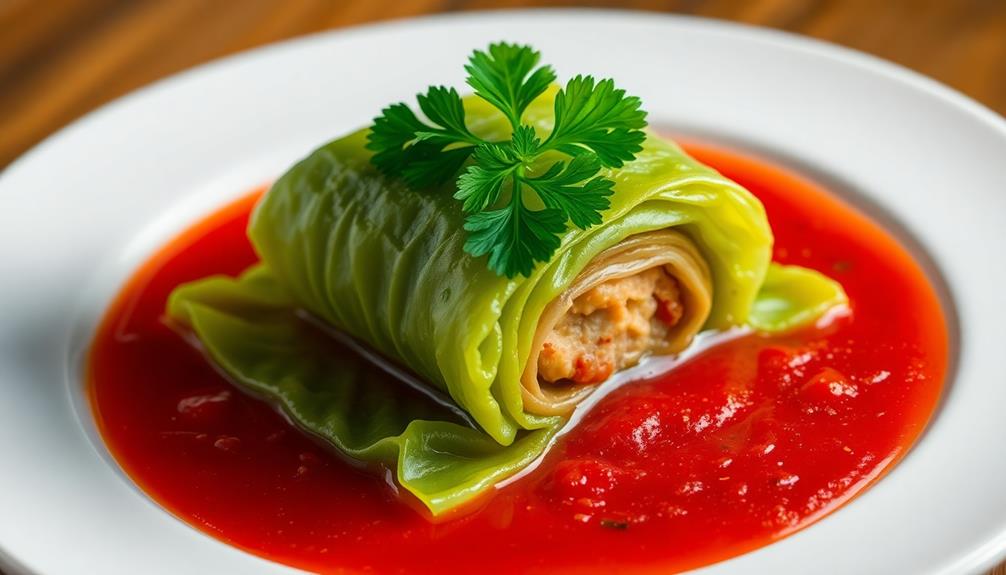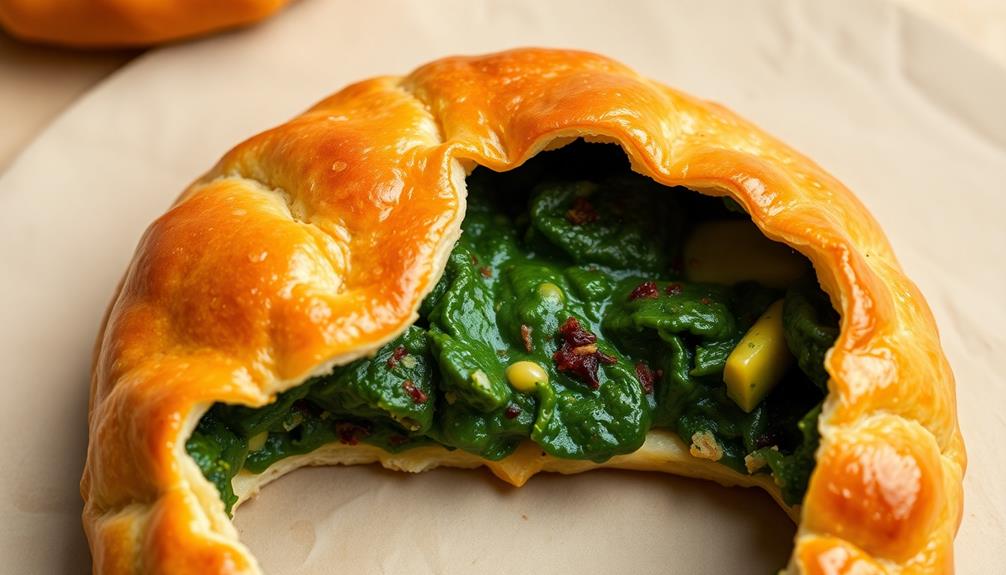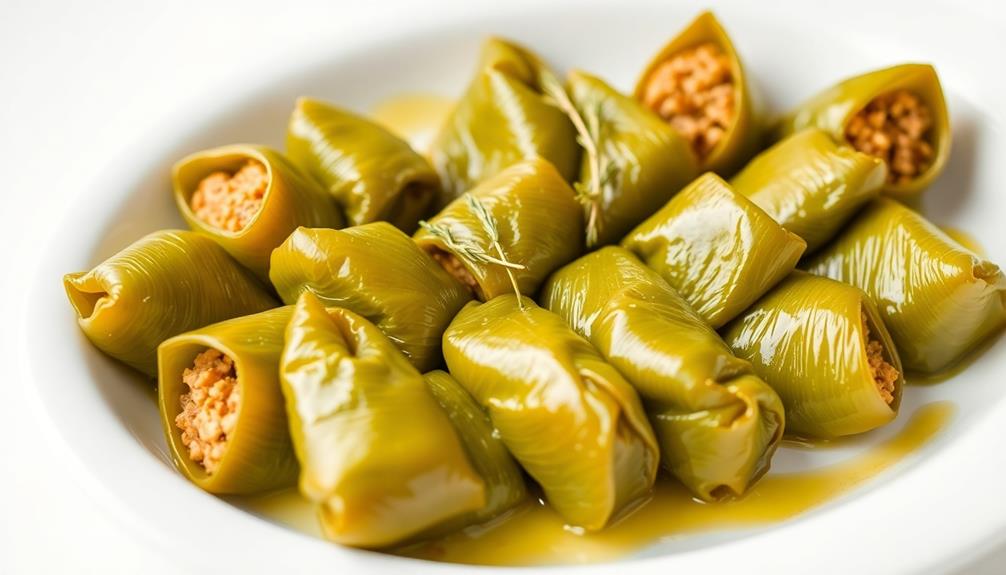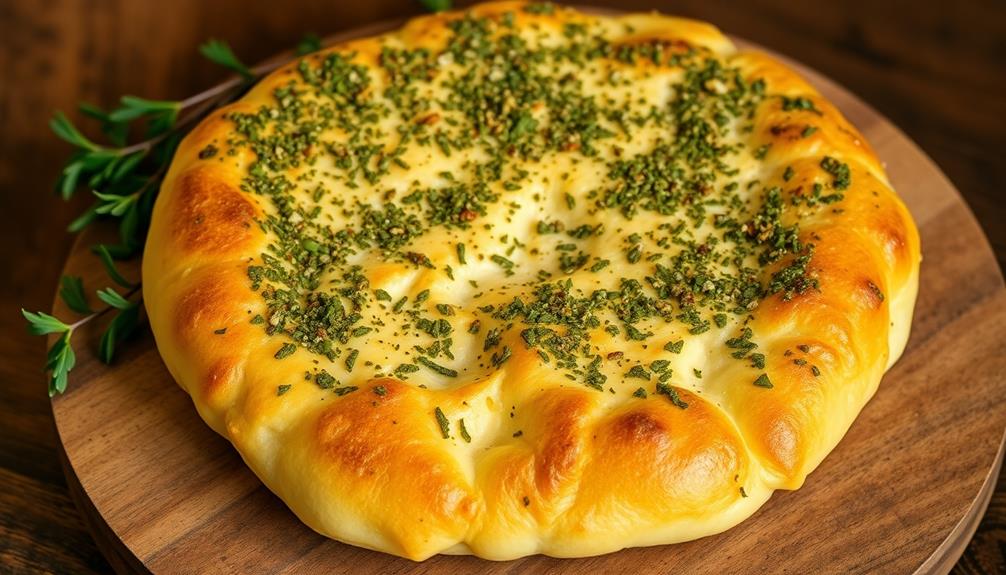Malfouf, the stuffed cabbage rolls, have been a beloved culinary tradition in the Levant region for centuries. Originating from ancient Rome and Greece, this dish has evolved, blending local flavors and spices. Prepare the cabbage by boiling and cooling the leaves, then stuff them with a savory mixture of ground meat, rice, onions, and garlic. Carefully roll the leaves and arrange them in a baking dish, pouring tomato sauce over the top. As the malfouf bakes, the aroma will fill your kitchen, hinting at the delicious flavors you're about to experience. Get ready to savor a true taste of Levantine heritage!
Key Takeaways
- Malfouf is a traditional dish from the Levant region, where cabbage leaves are stuffed with a savory filling and baked in tomato sauce.
- The term "Malfouf" means "wrapped" or "rolled" in Arabic, reflecting the dish's core cooking technique.
- Preparing Malfouf involves softening the cabbage leaves, creating a flavorful filling, and carefully assembling and baking the stuffed rolls.
- The cooking process enhances the flavors and ensures the tenderness of both the cabbage leaves and the filling.
- Malfouf showcases the rich culinary heritage and flavors of the Levant region, making it a visually stunning and satisfying dish.
History
Malfouf, the renowned stuffed cabbage rolls, trace their origins to the Levant region, where the dish has been a cherished culinary tradition for centuries.
The name "Malfouf" comes from the Arabic word "malfūf," meaning "wrapped" or "rolled." This age-old recipe has been passed down through generations, each family often adding their own unique twist to the filling and seasoning. Malfouf is a dish that is commonly found in Middle Eastern and Mediterranean cuisine. The traditional recipe consists of layers of cabbage leaves wrapped around a filling of rice, ground meat, and seasonings, which are then cooked to perfection. Similar to the traditional falafel recipe, malfouf is a beloved staple in many households and is often served as a comforting and satisfying meal.
The earliest records of stuffed cabbage dishes date back to ancient Rome and ancient Greece, where they were enjoyed as a delicacy.
As the dish traveled through the Middle East, it evolved, with each culture leaving its mark. The Levantines, in particular, embraced the dish, incorporating local ingredients and spices to create the beloved Malfouf we know today.
From the fragrant spices to the tender cabbage leaves, every bite of Malfouf is a testament to the region's rich culinary heritage.
Cooking Steps
Now, let's dive into the cooking steps for these delectable stuffed cabbage rolls.
First, you'll need to prepare the cabbage. Bring a large pot of water to a boil, then gently lower the whole head of cabbage into the water. Cook for about 5 minutes, until the leaves start to soften.
Carefully remove the cabbage and let it cool. Separate the leaves, being gentle so they don't tear.
Next, in a bowl, mix together the ground meat, rice, onion, garlic, and seasonings. Spoon this filling onto the center of each cabbage leaf.
Fold the sides over the filling, then roll up the leaf tightly. Arrange the stuffed rolls in a baking dish.
Step 1. Remove Tough Outer Leaves

To begin, peel off and discard the tough outer leaves of the cabbage. These leaves tend to be thick, dry, and tough, so you don't want them in your final dish. Gently pull the leaves away from the head, taking care not to tear the inner, softer leaves. You only need the tender, pliable leaves for stuffing.
Once you've removed the tough outer layer, you'll have a clean, compact head of cabbage ready for the next step. It's important to be gentle during this process to preserve the integrity of the leaves. You want them to be supple and easy to roll up with the filling.
Take your time and work carefully, peeling away the layers one by one. With a little patience, you'll have the perfect cabbage leaves, ready to be transformed into delicious malfouf.
Step 2. Chop Cabbage Leaves Into Strips
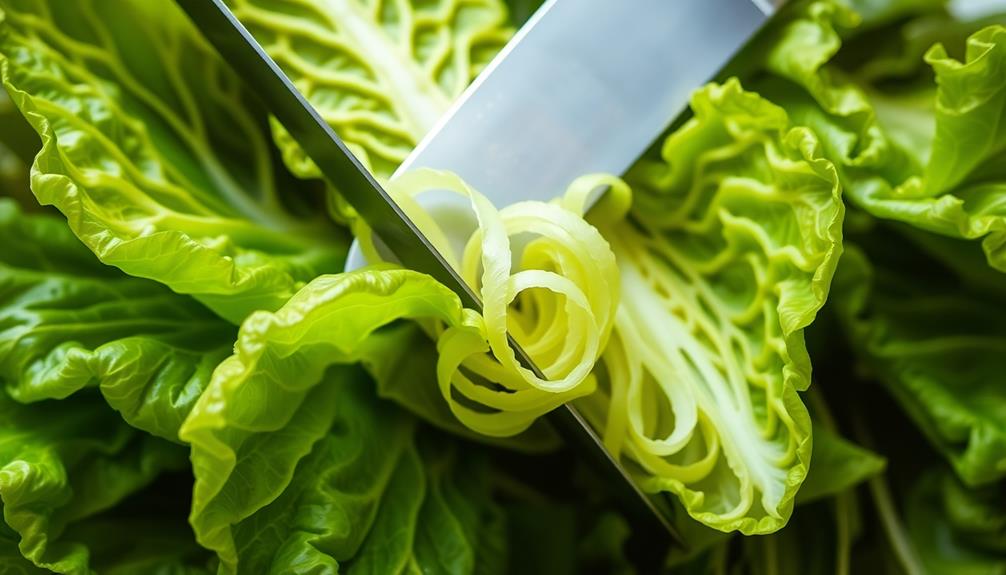
After removing the tough outer leaves, take the remaining cabbage leaves and chop them into thin strips.
Use a sharp knife and work carefully, cutting the leaves lengthwise into long, thin pieces. Make sure the strips are roughly the same size so they cook evenly.
As you chop, try to keep the leaves intact as much as possible – you don't want them to fall apart.
Once all the leaves are chopped, give them a gentle rinse under cool water to remove any dirt or debris.
Gently pat the leaves dry with a clean towel or paper towels.
Now that your cabbage is prepped, you're ready to start assembling your delicious stuffed cabbage rolls! The chopped cabbage leaves will be the perfect wrapper for the flavorful filling.
Step 3. Stuff Cabbage Leaves With Mixture
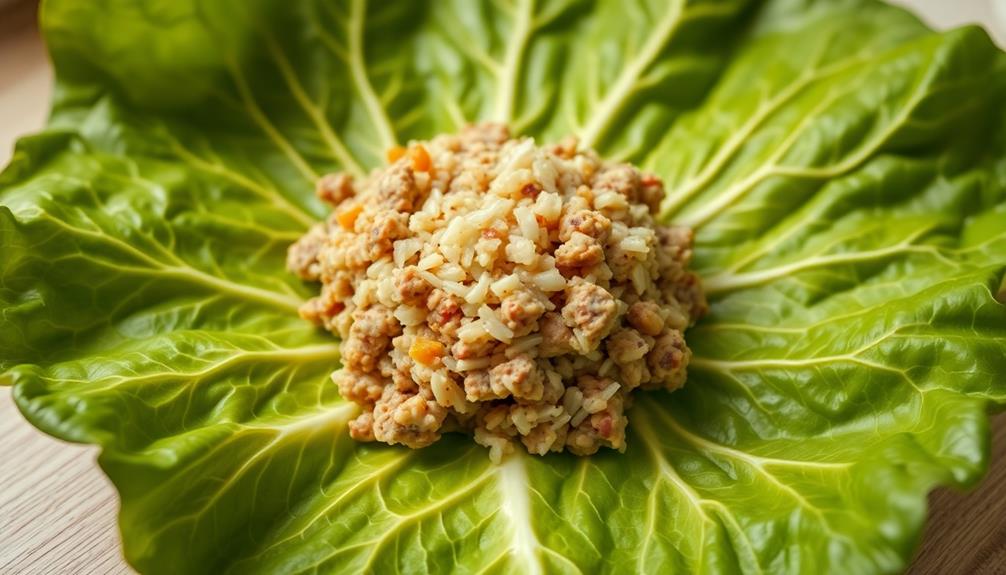
Gather the chopped cabbage leaves and a bowl containing the prepared filling mixture. It's time to start stuffing those leaves!
Grab a leaf and place a spoonful of the seasoned rice and meat mixture at the base. Carefully fold the sides of the leaf over the filling, then roll it up into a tight cylinder.
Place the stuffed leaf seam-side down in a baking dish. Continue this process, tightly packing the stuffed leaves side by side until you've used up all the filling and leaves.
Once they're all rolled up, pour the tomato sauce over the top, ensuring each roll is well-coated.
Cover the dish and bake the malfouf in the oven until the cabbage is tender and the filling is heated through, about 45 minutes.
The aroma of the warm, savory rolls will fill your kitchen, making your mouth water in anticipation. Get ready to enjoy these delicious, home-cooked stuffed cabbage rolls!
Step 4. Arrange Rolls in Baking Dish
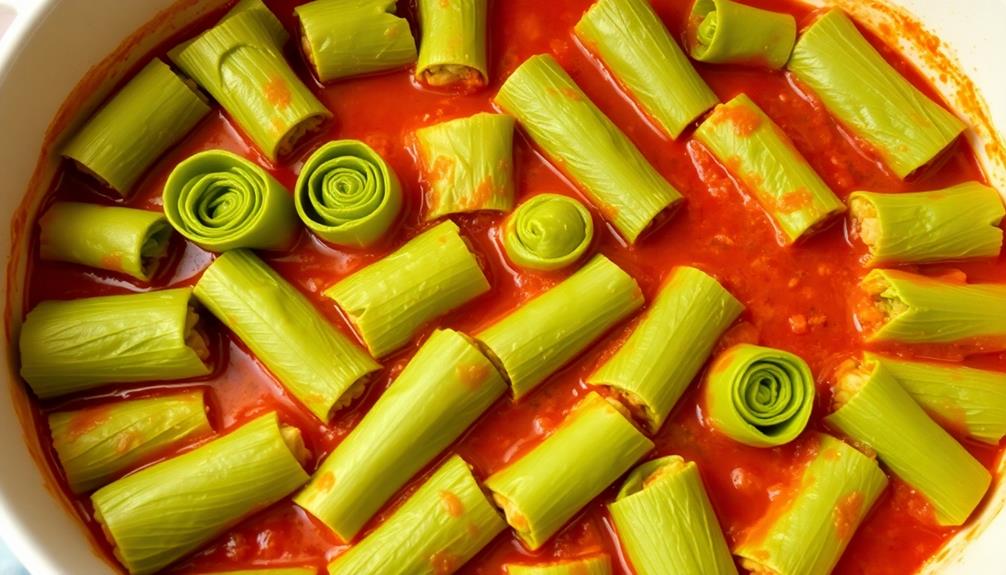
Grab the stuffed cabbage leaves and start arranging them in a baking dish. Place them snugly, seam-side down, in rows until you've covered the entire bottom of the dish. This'll help the rolls stay intact as they cook.
Once you've laid out all the rolls, pour the reserved tomato sauce over the top, making sure to coat each one. This will add tons of flavor as they bake. If you have any leftover filling, sprinkle it around the rolls too.
Now, cover the dish with aluminum foil and pop it in the oven. Let the rolls bake for about an hour, until they're heated through and the cabbage is tender.
Remove the foil for the last 15 minutes to let the tops get a little crispy. Mmm, can you smell that? Your house is gonna smell amazing!
Step 5. Cover With Tomato Sauce

Pour the reserved tomato sauce over the arranged cabbage rolls, making sure to evenly coat each one. This saucy coating will bring everything together, adding a delicious layer of flavor.
Slowly ladle the sauce, taking care to cover the sides and tops of the rolls. You want every inch of those tightly wrapped bundles to be blanketed in the rich, tangy tomato goodness.
Once the rolls are fully coated, you can cover the baking dish with a lid or aluminum foil. This will help the flavors meld and the sauce to simmer, infusing the cabbage and filling with its aromatic essence.
The covered dish can then be popped into the oven to continue cooking until the rolls are tender and the sauce has thickened. Soon, your kitchen will be filled with the irresistible scent of these homemade stuffed cabbage rolls, just waiting to be enjoyed.
Final Thoughts
Malfouf, the delightful stuffed cabbage rolls, have now come to a satisfying conclusion.
You've learned all about this delectable dish – from preparing the cabbage leaves to filling them with the savory rice and meat mixture.
And let's not forget the tantalizing tomato sauce that adds the perfect finishing touch.
As you look back on the journey, you can't help but feel a sense of accomplishment.
Mastering the art of malfouf is no easy feat, but you've risen to the challenge.
Now, you can impress your family and friends with your culinary prowess.
Serve these rolls with pride, knowing that you've created a dish that isn't only visually stunning but also bursting with flavor.
The combination of tender cabbage, aromatic spices, and the rich tomato sauce is a true delight for the senses.
So, savor every bite and bask in the satisfaction of a job well done.
Malfouf has become a beloved part of your culinary repertoire.
Frequently Asked Questions
What Is the Origin of the Name "Malfouf"?
The name "malfouf" actually has an interesting origin!
It comes from the Arabic word "malfouf," which means "wrapped" or "folded." This refers to the way the cabbage leaves are wrapped around the filling to create the classic stuffed cabbage rolls.
So the name perfectly describes the dish's unique shape and preparation.
Isn't that a neat bit of food history? Now you know the story behind this tasty Middle Eastern specialty!
Can Malfouf Be Made With Other Types of Cabbage?
Absolutely! You can make malfouf with other types of cabbage, not just the classic green variety.
Try using savoy or napa cabbage – their tender leaves will wrap around the fillings just as nicely.
Experiment with different types to find your favorite! The key is to choose a cabbage with pliable, easily-folded leaves that can hold the tasty stuffing.
How Long Can Malfouf Be Stored For?
How long can Malfouf be stored for? Well, you can keep this tasty dish in the fridge for up to 5 days!
Just make sure to store it in an airtight container. This way, you can enjoy your homemade Malfouf all week long.
It's the perfect make-ahead meal that'll have your family asking for seconds.
Is There a Vegetarian Version of Malfouf?
Sure, there's a delicious vegetarian version of malfouf!
Instead of using ground meat, you can stuff the cabbage leaves with a savory mixture of cooked rice, sautéed veggies, and aromatic herbs and spices.
It's just as flavorful and satisfying as the traditional recipe, but with a plant-based twist.
Give it a try – you'll be amazed at how tasty and versatile this dish can be, even without the meat!
Can Malfouf Be Frozen and Reheated?
Yes, you can definitely freeze and reheat malfouf! This tasty dish holds up really well to the freezing process.
Just make sure to properly wrap and seal the cabbage rolls before popping them in the freezer.
When you're ready to enjoy them again, simply thaw and reheat in the oven or on the stove.
With a little planning, you can have delicious malfouf ready to go anytime.
Isn't that exciting? Get ready to savor the flavors, even on the busiest of days!
